Narrelle M. Harris's Blog, page 21
April 22, 2019
Quintette of Questions: Julie Bozza
Julie Bozza asked Fletch and Albert (two of the three main characters in her about to be re-released novel) to help her answer today’s questions.
1.
What’s the name of your latest book – and how hard was it to pick a title?
 Fingerprints
FingerprintsFletch: The Definitive Albert J.
Sterne, because it’s all about Albert and how he’s determined to be the
absolutely best Albert he can. Though, for most of the book, he’s more of a
work-in-progress than he realises!
Julie: The title seemed very obvious to me, very early on, and it’s stuck
ever since. I thought about “quintessential” as an alternative, but
“definitive” seemed more Albert-ish to me. So that was that!
Albert: {glares grumpily at nothing in particular}
2.
If you could choose anyone from any time period, who would you cast as the
leads in your latest book?
Julie: I almost always cast my main characters, because I write by
creating the film of the story in my mind’s eye. I need those visuals in three
dimensions in order for it all to come alive. I don’t usually share the actual
names, though, as I like to leave readers free to imagine their own film of the
story – if you see what I mean. But let’s throw caution to the winds here! Over
to you guys.
Fletch: Given my Irish-American background, I think a young Gabriel Byrne
would be perfect.
Albert: {crosses his arms and looks mulish}
Fletch: {pointedly} Despite a certain lack of cooperation from others
{/pointedly}, Julie and I are determined to answer this in honour of the late,
loveable Miguel Ferrer, who she always envisaged as Albert.
Julie: How can it be two years already since he died? … Miguel was no
stranger to forensics and law enforcement roles, featuring in Twin Peaks, Crossing Jordan, and NCIS:
Los Angeles, among other films and TV series.
As for John Garrett, the third main
character, I couldn’t go past Brian Dennehy who was disturbingly good as John
Wayne Gacy in the TV film To Catch a
Killer. My Garrett isn’t Gacy, I should add, but the fact that Gacy existed
helped me feel confident that I wasn’t entirely making it all up to suit
myself.
3.
What five words best describe your story?
Albert: An unwarranted invasion of privacy.
Fletch: {much laughter} Poor Albert … {sobers up} All right, I think: love,
horror, determination, diligence … love.
Albert: You’re repeating yourself.
Fletch: There was a lot of love.
Julie: Love. Identity. Friendship. Anger. Passion. Peace.
Albert: That’s six words, as you’re well aware.
Julie: There’s over 226,000 words in this novel, so five just isn’t enough
to cover it!
4.
Who is your favourite fictional team/couple?
Fletch: Well, us, of course. Me and Albert.
Julie: Same for me, right now! Albert and Fletch.
Albert: Song Ci.
Fletch: … Who?
Albert: A Chinese judge and forensic medical scientist who worked in the
thirteenth century. He wrote a book titled Collected
Cases of Injustice Rectified.
Fletch: Now who’s not answering
the questions exactly? He was real? And what about his team or his partner?
Albert: Some of us prefer to work alone.
5.
What song reflects a theme, character, relationship or scene in your book?
Fletch: The song that always makes me think of Albert is “I Am a Rock” by
Simon and Garfunkel. It’s very beautiful, and very passionate – and very very sad.
{silence for long moments}
{Albert briefly reaches a hand, as if he
might touch Fletcher’s arm in reassurance}
Albert: Lawrence Durrell wrote, “But that is what islands are for; they are
places where different destinies can meet and intersect in the full isolation
of time.”
{Fletch reaches to grasp Albert’s hand, and
his smile is quietly brimming over with peace}
Fletch: Damn, I love you.
{fade to black}
About The Definitive Albert J Sterne
An obnoxiously immovable object is partnered with an undeniably irresistible force – in pursuit of a cruelly imperturbable serial killer.
Albert Sterne, forensics expert with the FBI, is so obnoxious on the surface that no one bothers digging deeper. When he’s sent to Colorado to investigate the work of a serial killer, he encounters Special Agent Fletcher Ash and they end up reluctantly joining forces to unravel the case. It’s only a matter of duty, though; it can’t be more, because Albert doesn’t do friendship – and he certainly doesn’t do love!
This well-respected novel was Runner Up (equal third) in the Best LGBT Mystery/Thriller category of the Rainbow Awards 2011. It is now being re-released, after first being published in two volumes by Manifold Press. The original novel and companion anthology have been stitched back together into one long tale.
Buy The Definitive Albert J Sterne
null Universal Buy Link The Definitive Albert J Sterne Amazon US The Definitive Albert J Sterne Amazon UK The Definitive Albert J Sterne Amazon AU The Definitive Albert J Sterne Amazon DE The Definitive Albert J Sterne Smashwords The Definitive Albert J Sterne Barnes & Noble The Definitive Albert J Sterne Kobo The Definitive Albert J Sterne Google Play The Definitive Albert J Sterne iTunes US
About Julie Bozza
 Julie Bozza
Julie BozzaJulie Bozza is an Aussie-English hybrid empowered by writing, fuelled by espresso, calmed by knitting, overexcited by photography, and madly in love with Amy Adams and John Keats.
Social media links:
Julie’s blog: http://juliebozza.com/ LIBRAtiger website: https://libra-tiger.com/ Twitter: https://twitter.com/juliebozza Goodreads: https://www.goodreads.com/juliebozza
Facebook: https://www.facebook.com/libratigerbooks/
April 18, 2019
Research: A home in Carlton
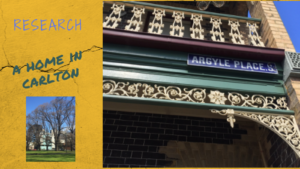
When Duo Ex Machina‘s Frank and Milo first appeared in a story, they’d just returned from Amsterdam – they were kinda big with the Dutch – to attend a funeral in Fremantle. They had no home but a hotel.
By the second story in 2004, they were on a publicity tour, and still no home was mentioned. At this stage, Frank had in fact inherited a flash house by the Swan River but here they were in hotels again. Milo’s mother and some extended family were dotted about Melbourne, though.
So here we are in 2009 with Number One Fan and I thought it was about time they had a home of their own. The house by the river was full of sad memories, and besides, it’s a lot harder for me to research locations when I don’t live in Perth any more.
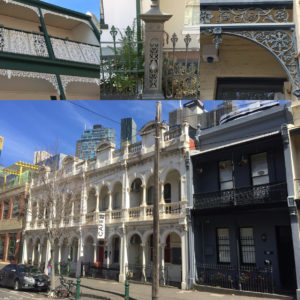
When looking for a home for them in Melbourne, I knew I wanted them to live in one of those beautiful Victorian-era two-storey houses with iron lace and stacks of charm. I knew I wanted them to be somewhere with an open view in front of them, in a suburb that connected to their Italian roots. While they had a heritage home, I wanted them to live somewhere full of young energy; maybe on the line between traditional and hipster.
After a bit of poking about, I kept coming back to Carlton. Although Lygon Street, also called ‘Little Italy’, is a bit overhyped, it’s still a lovely area when you get away from that central street. It’s said Melbourne cafe culture started here, with all the Italian restaurants. It’s home to La Mama Theatre (where playwright David Williamson made his debut), Readings Bookstore, Cinema Nova, and Italian delicatessens, and Melbourne University is just over the tramlines.
Carlton was established just after the Victorian Gold Rush, in 1851. It started out a bit posh – Sir Redmond Barry (the man who pronounced the death sentence on Ned Kelly) lived on Rathdown Street in the early days – but became a place of small industry and the working class. The Jewish population got their synagogue in 1919, and after WWII an influx of Italians strongly influenced the area’s character, along with all those hungry minds at the university.
Some beautiful houses with iron lace are dotted all about Carlton. Quite a few parks are in the area too. I went for a walk around it one recent sunny day to choose where I’d like their house to be, and to see what was nearby.
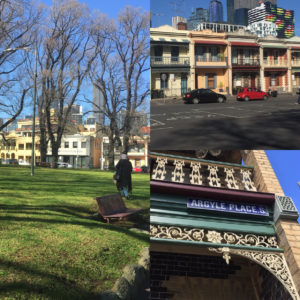
This row of terrace houses opposite Argyle Square was the best option. From those front balconies, people can look over the English elms in the park and see the students lollling about on the lawn to study, or families picnicking and eating ice-cream they bought up on Lygon Street, a short walk away. Around the corner is The Lincoln Hotel if they want a quietish drink. At the Lygon Street end of the square is what was in 2009 a red brick power substation, but as of a few months ago is a new cafe called Parco.
The location was right but the houses there weren’t so I took some small streets, crossing Lygon and heading towards Drummond and Rathdown Streets. There I found two lovely white terrace houses. One of them has beautiful leadlighted decorations on the downstairs window and above the door. The other was plainer at ground level, but had lovely etched glass in the upstairs window and the balcony door.

A wee bit of googling gave the prices that they last sold for. One of them, with three bedrooms, two bathrooms and even a car space, went for $800K in 2005. I think Frank’s Swan River place would have covered that.
Of course, Frank and Milo’s place isn’t really real. I’ll be playing around with its insides and outsides, maybe having them refurbish and add a fancy music room onto the back of the house while the front gazes onto the park with its demure 1890s lace of iron.
April 15, 2019
Quintette of Questions: Karen J CarLisle
Today I’m asking five questions of:
Karen J Carlisle!
1. What’s the name of your latest book – and how did you choose the title?
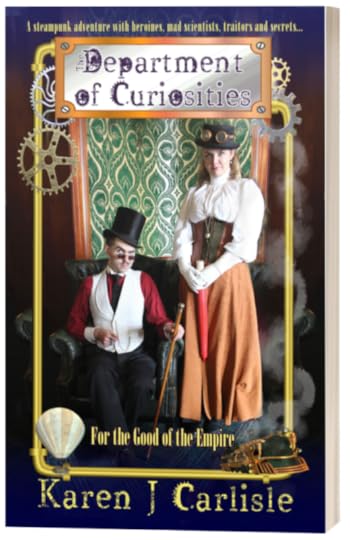
My latest book is The Department of Curiosities. This is
the first book in a new steampunk adventure series. It’s set in the same alternative
history world as my first series, but has a lighter feel.
I always had a fascination for
Victorian curiosity cabinets, especially the ‘scientific’ ones. Back in 2012, I
wondered what would happen if new scientific inventions were locked away in a
similar fashion, then the title popped into my head. And then I wondered ‘what
if’ they were locked away ‘for the good of the Empire’? ‘The Department’ sounds
like a clandestine Victorian agency.
2. If you could choose anyone from any time period, who would you cast as the leads in your latest book?
… 2 days later…
This is such a difficult
question. There are so many factors. I decided to stick with actors:
Tillie is a newcomer, Sir Avery
is handsome, cheeky and prefers to be known for his achievements, not his
birthright. Harrow likes to hide in the shadows, and the General has presence…
My final decisions:
Tillie Meriwether: Eleanor Stankiewicz (young and upcoming Australian actor. Okay, so she’s also a friend… )Sir Avery Allington: Henry Cavill Harrow: A young Alan Cumming. The General: Ian McKellen/ an older Lawrence Oliver
3. What five words best describe your story?
Steampunk.
Adventure. Intrigue. Betrayal. Friendship.
4. Who is your favourite fictional couple or team?
The Doctor and Donna (Doctor Who):Theirs is a meeting of minds:
education and street smarts. They complement each other, bring out the best in
each other. There’s no sex involved. The relationship is like soul mates or
close siblings/cousins. And there’s witty banter.
5. What song reflects a theme, character, relationship or scene in your book?
Well… um… (not meant to be a shameless plug, but…) The Gadgeteer was written specifically for my alternate steampunk world. Words: Karen J Carlisle/ Music: Richard Ryall. Performed by the Littmus Steampunk Band.
The Department of Curiosities series revolves around the acquisition (or lack
thereof) of mechanicals (or gadgets).
On one side there’s Queen Victoria who feels all mechanicals should be
controlled, for the Good of the Empire. The Department of Curiosities is
charged with collecting, archiving and preventing the illegal importation of mechanicals.
Many feel mechanicals should be accessible by all, for the benefit of all. And
the Gadgeteers are lobbying (by whatever means) to be able to freely sell
mechanicals (for their own profit).
You can hear a sample here: https://karenjcarlisle.com/product/song-the-gadgeteer/
About The Department of Curiosities
The Department of Curiosities: a steampunk tale of adventure, a heroine, mad scientists, traitors and secrets. All for the good of the Empire.
Miss Matilda Meriwether has a secret. Actually, she has several. One of them has shaped her adult life. Another now controls it.
Her Majesty Queen Victoria has control of the Empire. She is the Empire, and creator of its secrets.
Sir Avery works for The Department of Curiosities – the keepers of secrets – especially if they are useful to the Empire.
When Tillie finds herself in the employment of The Department of Curiosities, she realises this is the perfect opportunity to uncover the truth she has been searching for.
But the Queen has other plans for her.
About Karen J Carlisle

Karen J Carlisle is a writer and illustrator of speculative
fiction – steampunk, Victorian mystery and fantasy.
She graduated in 1986, from Queensland Institute of
Technology, with a Bachelor of Applied Science in Optometry, and lives in
Adelaide with her family and the ghost of her ancient Devon Rex cat.
Karen first fell in love with science fiction when she
saw Doctor Who, as a four-year old. This was reinforced
when, at the age of twelve, she saw her first Star Destroyer. She started
various other long-term affairs with fantasy fiction, (tabletop) role-playing,
gardening, historical re-creation and steampunk – in that order.
She has had articles published in Australian Realms Roleplaying Magazine and her short
story, An Eye for Detail, was short-listed by the Australian
Literature Review in their 2013 Murder/Mystery Short Story Competition. Her
short stories have featured in the 2016 Adelaide Fringe exhibition, ‘A Trail of
Tales’, and the ‘Where’s Holmes?’ and ‘Deadsteam’ anthologies.
She writes full-time and can often be found plotting
fantastical, piratical or airship adventures, and co-writing the occasional
musical ditty.
Karen has always loved dark chocolate and rarely refuses
a cup of tea.
She is not keen on the South Australian summers.m
Website: Karen J CarlisleNewsletterFacebookTwitterInstagramPatreon
Pre-order The Department of Curiosities
Karen J Carlisle

April 11, 2019
Research: Aboriginal Melbourne
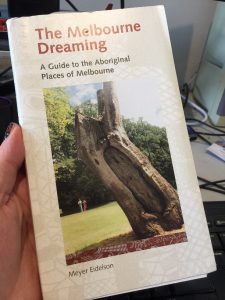
In both my contemporary and historical fiction set in Melbourne, I aim
to include, where possible and appropriate, more details of Melbourne
before white settlement.
Sometimes this involves a bit of googling – most recently I’ve used a language map to check what language groups existed in and around Ballarat, for a story being submitted to a new anthology.
For that same story I also wanted the Indigenous character to speak a few words in his own language – Wadawarrung. I was thrilled to discover in my searches an app! The Wadawurrung Language app is beautifully laid out. So much of the language has been lost, but this is an elegant and helpful introduction.

However, for a more comprehensive overview of Melbourne and its importance to the Kulin nations, I have The Melbourne Dreaming: A Guide to the Aboriginal Places of Melbourne by Meyer Eidelson. I have an old edition, but a new one was published in 2014.

The Melbourne Dreaming tells the story of Aboriginal Melbourne around the Yarra River, Merri Creek, Port Phillip Bay, Maribyrnong River, Melbourne city and some places around, including Sunbury, Corinella and some locations hard to get to. Most entries are accompanied with a Melways map and reference so you can visit these places yourself.
If you want to learn more about Australia’s pre-colonial heritage, and about the traditional custodians of this land, it’s a fantastic guide.
April 4, 2019
Melbourne Research: Brother Baba Budan

This cafe, at 359 Little Bourke St, Melbourne , is named for the man who reputedly first smuggled coffee beans out of Yemen (and consequently brought joy to the world).
A version of BBB appears in the first chapter of Number One Fan. The cafe isn’t identified by name in the story, but the cosy, industrial ‘distressed’ look of the walls, the metal scoop that is a door handle and, of course, the inverted forest of chairs hanging from the ceiling are reflected in the look of the story version.
In 2009, BBB was run by the owner of North Melbourne’s St Ali, another great Melbourne cafe. (In 2019 it gets its house roast from Seven Seeds, another Melbourne coffee superstar.)
It’s tiny, with one communal table and a few stools scattered around periphery benches. The only food it serves are a few pastries, which are also excellent. I rarely have to queue for coffee, but there can occasionally be a short wait while visitors armed with guide books come to take pictures of the ceiling’s bristling chair legs and of course the coffee.

I prefer other people to make my coffee – an espresso-machine cafe latte is da bomb! – but we get their house blend and their decaf for making plunger coffee at home, for those hours when *gasp* BBB is closed!
I suppose it’s cheating to call it research to drink here, but I’ll do that anyway, because that makes me happy, and you should do the things that make you happy, right?
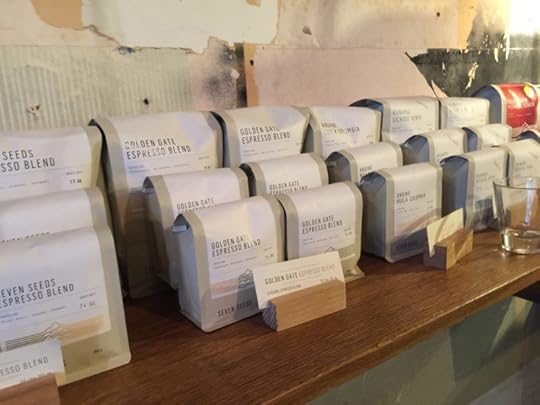
Because it’s tiny, there’s not always somewhere to sit and enjoy watching the staff being so professional and the Melbourne coffee crowd being so very appreciative of their excellent brew.
Instead, bring a Keep Cup or equivalent, get your coffee to take away, and sit on the steps of the Melbourne GPO (though not at its own excellent cafe on its terrace, obviously). Contemplate your delicious sins while watching the trams, and decide if you’ve done enough of them.
April 1, 2019
Quintette of Questions: Elise Clarke
Answering five questions for me today is:
Elise Clarke

1. What’s the name of your latest book – and how did you choose the title?
My Lady Original. It’s in a series but luckily the editor picked it for me.
2. If you could choose anyone from any time period, who would you cast as the leads in your latest book?
Ooh: Santiago Cabrera for Jack (see him as Aramis) and someone like Isabella Bird, the Victorian explorer, for Hermione – she had to be slightly batty to manage what she did, very talented and with a mind of her own. I love the anime book of her.
 Hermione and Jack
Hermione and Jack3. What five words best describe your story?
Prince Charming fights fairy tales.
4. Who is your favourite fictional couple or team?
Jane Eyre and Mr Rochester; she’s so much stronger/worthier than he is, and he loves her for it. He’s made some terrible mistakes in life but he gives her the chance to have a better life of her own, and he always has her back. You can really see them loving each other forever.
5. What song should be the theme of your book?
Super Trouper by Abba – completely the wrong period but a brilliant, upbeat song about someone who seems to have everything (Jack) but needs someone slightly mad (Hermione) to bounce in so he’ll be “shining like the sun”. It’s also pretty much guaranteed that Hermione would “be changing everything”!
About My Lady Original
Jack, Lord Darenth is London’s favourite paragon, staggeringly handsome, always fashionable, and unshakeably single. But when
The Conqueror, a smash–hit novel casts
him as a thinly veiled, lovelorn Prince Charming searching for the
perfect match, all of society loses their collective heads – and their
hearts – and pandemonium breaks all over Jack’s
well–ordered life.
Lady Hermione thinks Lord Darenth is handsome enough, when she bothers to think about him at all. For her, he is but the best friend of her own dear friend Sandy, the man she is considering for a husband. But when the sequel to The Conqueror is published featuring her as a drippy Cinderella heroine to Darenth’s hero, she is galvanised into action. Ignoring the book doesn’t work, so it’s best to proceed as if it doesn’t matter. Until life starts imitating art, and suddenly the possibility of a love story in truth becomes all too real…
About Elise Clarke

Elise Clarke is a history fanatic with a weakness for tall, handsome men, humour and the non-traditional. She lives in England with her family.
Follow Elise at www.eliseclarke.com
Buy My Lady Original
M y Lady Original (Harper Collins)My Lady Original [image error] (Amazon US) My Lady Original (Amazon UK) My Lady Original (Amazon Australia) My Lady Original (Kobo)
March 28, 2019
Research: Melbourne in 2009
The next book in the Duo Ex Machina series, Number One Fan, is set in Melbourne in 2009.
What was going on in Australia and Melbourne that year?
For a start, I found and photographed this plaintive sign which had been shoved into a bin down near the Sofitel Hotel, on the Flinders Lane side.

I never did find out why the placard had been made or why it had been dumped as though it caused the placard-maker pain, but the sign and its sad ending have always made me wonder what the story was.
In 2009, Australia’s Prime Minister was Kevin Rudd. He and the Labor Party had won government by a landslide in 2007 and he promptly signed the Kyoto Protocol, apologised to the Stolen Generations, finished pulling Australian troops out of Iraq and instigated several education and communications policies, including the National Broadband Network.
It was kind of downhill after that, and in mid-2010 he was replaced by his deputy, Julia Gillard. But that’s a whole other year and not part of Frank and Milo’s 2009 story.
In that year, Australia was playing it’s regular game of Natural Disaster Bingo, with floods in Queensland, the Black Saturday bushfires in Victoria that killed 173 people, torrential rains in NSW, followed by more floods in Queensland and NSW.
This was the year Geelong won the Septemer AFL Grand Final and Shocking won the Melbourne Cup in November.
In February, the St Jerome Laneway Festival overflowed its location after four successful years (leading to new locations in 2010 that would fit everyone). The line-up included The Temper Trap, Tame Impala and Architecture in Helsinki.
The Black Eyed Peas, Kings of Leon, Lady Gaga and the Hilltop Hoods were all over the charts. Jessica Mauboy and Guy Sebastian were in the Top 100 too.
So that’s a taste of what was happening in 2009, when Frank and Milo are recording a new album, setting up an office to deal with admin, and find themselves drawn into another maelstrom of crime and danger.
March 25, 2019
My Library: Musketeers meet Bohemians
Sometimes in my reading, unscheduled juxtapositions result in the sparking of questions.
That happened this year when I finally read the original version (English translation) of Alexandre Dumas’ The Three Musketeers and then, a month later the 1888 English translation of Henry Murger’s La Vie de Boheme.
I’d come to the Musketeers after a year of falling in love with, first Tansy Rayner Roberts’ splendid genderswapped Musketeer Space and then, on her recommendation, the fabulous BBC Musketeers series. I’d of course seen lots of other interpretations, including the one with Gene Kelly as D’Artagnan, so I thought it high time I returned to the source.
 Front cover for the serialisation.
Front cover for the serialisation.It’s easy to see why Dumas’s swashbuckler lives on in the popular imagination. It’s only partly for the four lead characters who, frankly, are as irresponsible and irritating a collection of feckless dudebros you would ever care to avoid. They’re brave and brilliant swordsmen, of course, and outstanding as a band of men dedicated to their timeless bromance, but such a bunch of yahoos.
Give me BBC and Rayner Roberts – who have granted the characters greater depth and more agency without losing any of the original’s swashbuckling, conspiring, dangerous, duplicitous delights – any time.
I think the real appeal of The Three Musketeers is the engagingly grey backdrop, where allegiances may be split between the King, the Queen and Cardinal Richelieu but ultimately everyone is for France. The enmities between those three and the Musketeers aren’t as straightforward as you’d think, and while Milady is a delicious villain, her angelic counterpart Constance has enough depth that you wonder what Dumas was thinking to fail to use her better in the latter half of the novel.
(Thank you BBC Musketeers for not only getting all these female characters so right, but also giving them longer, better, stronger lives than they had in their origin story.)
But what has all this to do with Henry Murger?
I have this book on my Kindle as a reference, because Dr Watson mentions reading La Vie de Boheme (I assume in French, since he uses the French title) during A Study in Scarlet. (I have one or two other books that Holmes and Watson talk about in that book, still waiting to be read.)
 John Watson reads Henri Murger while waiting for Holmes to return. He’s skipping over the pages so perhaps he didn’t like it very much.
John Watson reads Henri Murger while waiting for Holmes to return. He’s skipping over the pages so perhaps he didn’t like it very much. I’d somehow developed the impression this was a serious book all full of drama and poetry about art and consumption, but it’s actually quite a lively comedy, frequently reminding me of how PG Wodehouse writes about his American poets and playwrights living impoverished, ink-spotted lives in Greenwich village.
I discovered other things when I finally stuck my nose into the book – published in English in this edition as The Bohemians of the Latin Quarter. Reading it only a month after Dumas, I was immediately struck at how the lives of musician Schaunard, philosopher Colline, artist Marcel and poet Rodolphe echoed so strongly the behaviours of those famous Musketeers.
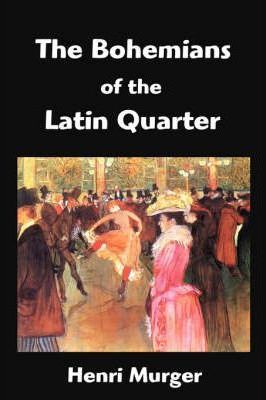 The English translation.
The English translation.All four Bohemians live in the moment, spending money freely and collectively when they have it, conspiring to borrow or make do when they don’t, all with a cheerful will and devil-may-care attitude. They approach women, landlords and publicans all with the same dash of cavalier bonhomie and are as fickle with women as the most dashing King’s Musketeer. Athos, Porthos, Aramis and D’Artagnan would, if they’d for just one second stop stabbing every person who insulted them or looked at them funny, would fit in very well in the Latin Quarter. Both Bohemians and Musketeers suffer tragedies in love (though for very different reasons).
Were the Musketeers, I wondered, secretly Bohemians?
I honestly don’t know at this point. I found nothing in my immediate Google searches that provided essays by scholars on the issue.
What I did find is that Dumas and Murger both lived in Paris in around the 1840s, when Murger first wrote his contemporaneous short stories (later collected in 1851) and Dumas began serialising his 17th century Musketeers.
Both books have characters based on real people, some of whose names have been disguised. Both writers had works adapted for the theatre – Dumas helped to establish the Theatre Historique while Murger’s works were staged at the Theatre des Varietes.
The mid 1800s were a time ripe with social upheaval, revolutions and the flauting of convention. In fact, the 1848 February Revolution was hovering on the horizon when Dumas and Murger were writing, and their fortunes diverged afterwards, with Dumas leaving the country for Belgium in 1851 after falling out of favour with Napoleon III. In comparison, this same Napoleon sent money to help an ailing Murger (to no avail, alas, and he died at age 38 in 1861).
 And Scenes de la Vie de Boheme in the original French
And Scenes de la Vie de Boheme in the original FrenchI’ve no doubt there’s giant blocks of political and social history I don’t know about Paris of the 1840s. What I do know is that Dumas and Murger may not have influenced each other, but were at least influenced by the times and city in which they lived – a Paris full of the energy and uncertainty of brewing revolution and the love of art and literature and experimenting with social convention.
The Three Musketeers, set 200 years before the turmoils of Dumas and Murger’s lifetimes, may not have been deliberately Bohemian but those dashing swordsmen, like Schaunard and the rest of Murger’s scrappy artists, were born when Bohemian Paris flourished.
Both books went on to inspire dozens of adaptations (La Vie de Boheme inspired two operas called La Boheme, and in time the musical Rent).
Whatever the connections or otherwise, I can recommend the value of going back to the source – finding the classics and discovering for yourself their virtues and failings, and maybe inspiring a side trip into historical research (or opera) while you’re at it.
March 21, 2019
The Waiters Club
Although the sign says The Waiters Restaurant, everyone knows this place as The Waiters Club. It’s a very simple Italian restaurant, upstairs at 20 Meyers Place, Melbourne.
 Image from Tripexpert
Image from TripexpertThere’s nothing flash about The Waiters Club – it opened in 1947 and by 2009, it didn’t appear to have been refurbished since the 1970s, with its white walls, dark wooden tables, an arched window overlooking a burgundy canopy, and chalkboard menus. (It’s not updated its look much since then either.)
Originally, it was the restaurant inhabited by Melbourne chefs and waiters once their own restaurants had closed up in the small hours. It served traditional Italian dishes and cheap alcohol, the latter in defiance of Melbourne’s strict and limited licensing laws. Reputedly, visitors had to give a password to enter the door at the top of the narrow staircase, like a first floor speakeasy for pasta.
The sly grog days are long gone, but the aura of a seedy past clings to the restaurant, with the owners’ encouragement, because of an incident in 1978 which began as a daring raid and ended in hilarious farce.
The Waiters Club Siege took place on 31 March, 1978.
18-year-old Amos Atkinson, a hot-head who had fallen in with notorious Melbourne gangster Chopper Read, had a run in with the police. After pursuit, Atkinson and his friend Robert Williams pelted up the stairs and ended up taking the 30-odd diners and staff hostage. Atkinson then came up with the bright idea of threatening to shoot hostages unless Chopper Read was released from prison.
Read had recently held a gun to a judge’s head, and so the authorities were naturally reluctant to comply. The police did nothing, leaving Atkinson hanging.
Atkinson’s next bright demand was to send a hostage out with the message that Atkinson wanted to speak to his mum.
Mrs Atkinson, bless her, showed up in her dressing gown and a hundred tons of attitude. She marched up the stairs, hit her son on the head with her handbag, told him to give himself up, and he did.
Far from trying to hush it up, the Waiters Club owner, Dennis Sabbadini, proudly has the newspaper clippings framed and hung on the wall for people to read and marvel over. Not only Dennis but all of Melbourne has been dining out on that story for forty years.
 Image from Time and Tide blog
Image from Time and Tide blogYou can read more details of the most bogan siege in the history of suburban small time crooks at:
Beside the Yarra Traveller John Silvester in The Age
I’d intended for Frank and Milo to go there for dinner in Number One Fan but they never made it. Perhaps they’ll saunter along in Kiss and Cry.
March 14, 2019
My Library: A is For Arsenic by Kathryn Harkup

Cheering, flaily-hands thanks to Sally Koetsveld, who gave me A is for Arsenic: The Poisons of Agatha Christie as a gift two Christmases ago, before I went to Lorne for a break.
Kathryn Harkup is herself a chemist, as well as a writer and avid reader of Christie. This makes her the perfect choice to write about the kinds of poisons Christie used in her stories from the combined storytelling and scientific points of view.
Some of the books I get for research I dip in and out of. Some, like this one, I read cover to cover. A is for Arsenic was perfect reading for a beachside holiday. Well. If you’re me.
It’s not an A-Z, but 14 letters of the alphabet are covered, describing the poisons most commonly used by Christie in her stories. Agatha Christie’s background as a dispenser in 1917 and beyond meant she was very familiar with several common poisons and their effects.
Harkup examines the stories in which they’re used (usually mostly spoiler-free or with clear warning before the spoilering commences). She talks about each poisons origins, whether they have antidotes in both the historical and contemporary contexts, how right Christie got the symptoms in the story and exactly how these poisons work in the body to kill the victim. The latter is pretty technical, but also very clearly laid out.
When you write both Victorian-era and contemporary crime and horror, a book like this is a superb helpmeet. With it, I can determine, for example, how much either Dr Watson’s medical background, or Holmes’s as a chemist, will inform their responses and deductions, how easily a poison might be obtained, and how long it might take someone to expire (or be saved!).
A is for Arsenic is entertaining reading on its own, but as a tool for the writer, it promises to be both a useful reference work and a probable source of inspiration!



